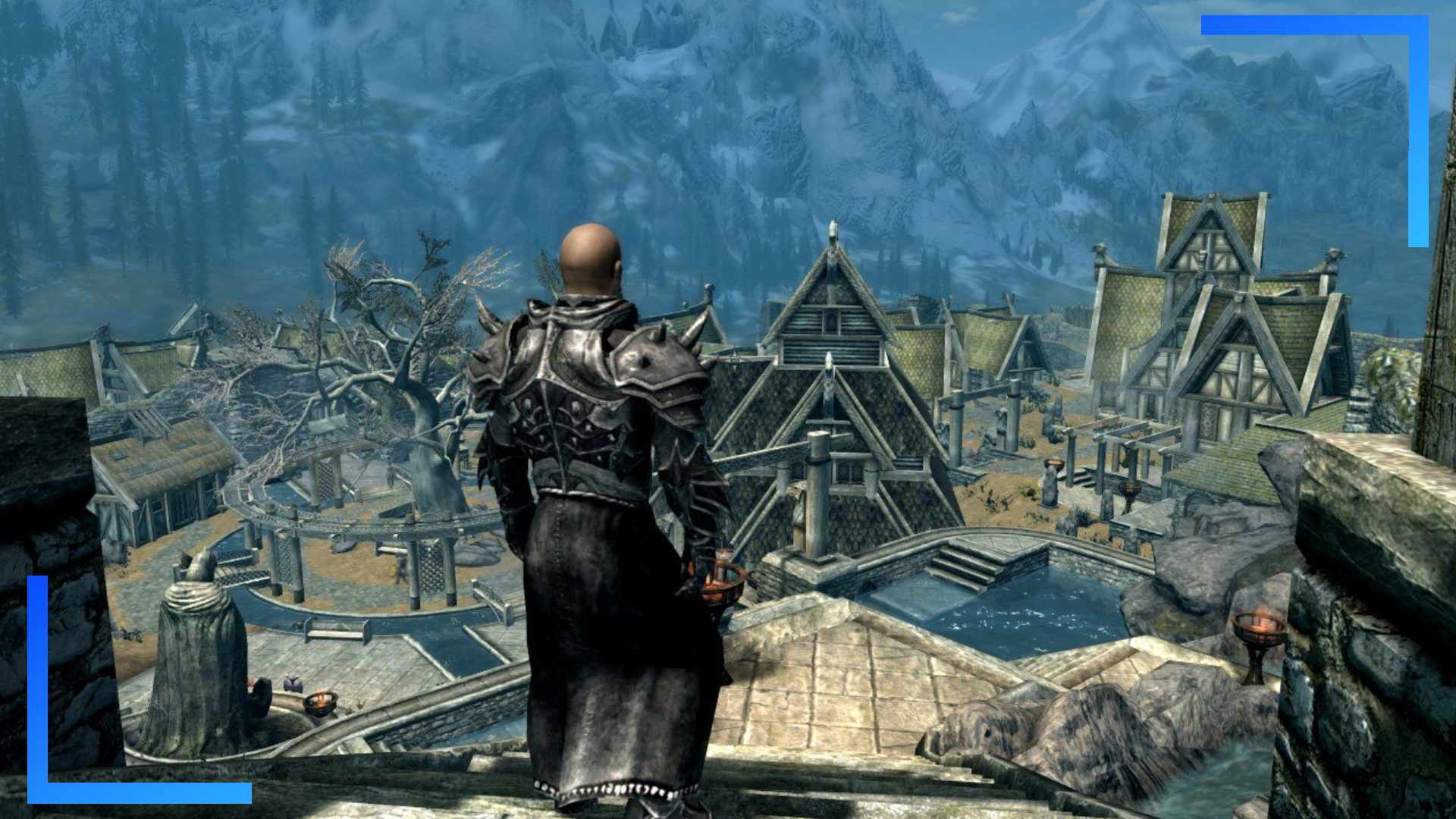Performance Overview


Left: Skyrim running on medium. Right: Skyrim running on high.
Let’s face it, if you’ve played Skyrim on PC, there’s a high chance you’re going to want to play it on Steam Deck. I know this because I – like many others – have spent far too many hours playing Bethesda’s role-play game.
I’ll admit I was somewhat concerned coming into Skyrim on Steam Deck. It’s a game that’s held together by aging duct tape and wishful thinking, and how well the Steam Deck could mimic the PC experience was up in the air.
As it turns out, Skyrim runs really well on the Steam Deck. I know, I’m just as shocked as you are.
Skyrim doesn’t have anything near a stable framerate, but then it doesn’t on PC and console either. That said, the drops are rarely felt. Frames will dip into the high-40s, before instantly returning back into the 50 to 60 frames range. I’d even go as far as calling the experience smooth.
Visually, Skyrim doesn’t match the crispness seen on consoles and high-end PCs, but it’s still a massive step up from the original release. Textures are clear and visible, shadows render smoothly, and load times are relatively fast.
Also, to my sheer delight, you can mod Skyrim on Steam Deck. While it’s not as clean as installing mods on Windows, the fact it’s possible once you’ve downloaded the right tools makes the Steam Deck version a must for fans of the series.
During the review period, I was able to install texture mods, co-op, SKSE, cheats, and a mod to enable achievements while mods are active, to name a few. I’m not saying every external mod will work flawlessly, but enough of them do work to make the venture worthwhile.
And the best part? With the settings below, very few of the mods I applied affected performance in any meaningful way. You really couldn’t ask for a better way to play Skyrim on the go.
Recommend Settings
The biggest hurdle with Skyrim on Steam Deck is the Godrays – light that pierces through foliage, cracks, and holes in walls. It’s stunning for sure, but it’s also going to limit how well the game runs.
That’s why I recommend turning it off. Yes, it looks really pretty, but it’s also a massive GPU hog that it’s not worth sacrificing the framerate to accommodate it. Plus Skyrim still looks great on the Deck’s hardware, it’s just the lighting doesn’t beam as much.
I also recommend sticking with the settings set to medium. It’s possible to play on high for everything, but the frame rate does dip slightly and the extra pressure on the visuals means a shorter battery life.
By sticking with medium settings you get an extra 40 minutes of battery, and if I’m being honest, there isn’t enough of a difference between medium and high to make it worthwhile.
Shadows are slightly more luscious and light curves around objects a little more on high, but it’s only really noticeable if you’re paying super close attention.
Plus if you’re planning on modding Skyrim, freeing up that extra graphical and processing power is sure to come in handy down the line.
I played with around 10 mods with the settings below and noticed zero slowdowns or anything too adverse. Even when the screen gets busy, I’m still well within the 50 to 60 frames threshold. Not bad for a handheld, eh?
| Skyrim (In-game Settings) | |
| Resolution |
1280×800 (16:10) |
| Antialiasing | TAA (Best quality) |
| Detail | Medium |
| Advanced | |
| Shadow Quality | Medium |
| Shadow Distance | Medium |
| Decal Quality | Medium |
| Godrays Quality | Off (best performance) |
| Screen Space Relfections | On |
| Screen Space Ambient Occlusion | On |
| Percipitation Occlusion | On |
| Snow Shader | On |
| Lens Flare | On |
| Distant Object Detail | Medium |
| Object Detail Fade | Medium |
| Steam Deck Settings (Quick Access Menu) | |
| TDP: 10 (50-60 frames) | Estimated Battery Life: 2 Hours 30 Minutes |
| Docked Mode Resolution: 1280×720 | FSR: On (Docked Mode) |
| GPU Usage: 90% | Temperature: 58 degrees |
| Extra Info | |
| Fills the Entire Steam Deck Screen | Yes |
| Valve Grading | Playable |
| Skyrim Version Tested | Special Edition |
| Performance Rating: 4/5 | |
Skyrim Bugs and Issues
While I don’t believe there are many Steam Deck-specific issues to speak of, it’s worth mentioning Skyrim will forever be an unstable game. Crashes will happen, characters will occasionally do something unexpected, and there’s always a chance if you jump at something at the wrong angle, you could clip through the floor.
Obviously the state of the game isn’t ever going to be good enough, and it’s important to hold Bethesda to higher standards. That said, fans of The Elder Scrolls franchise have come to expect as much, and Skyrim – for the most part – is playable and enjoyable from start to finish. So long as you aren’t expecting perfection, you’ll likely come away pleased.
Conclusion
I’d wager Skyrim on the Steam Deck is one of the best ways to play it. Being able to play Skyrim anywhere is fresh, and being able to mod it is icing on the mountaintop. Sure, it doesn’t hit the highs of the PS5 counterpart, but with external mods, you can reenergize Skyrim in a way you can’t on PS5.
It’s not perfect by any means, but the core gameplay is there and performance is solid across the board (once you disable Godrays), making Skyrim really easy to recommend.

Disclosure: Review copy purchased online. | All screenshots captured on Steam Deck.| To learn more about our review policy click here. | Alternatively, click here to find out why you can trust me.

